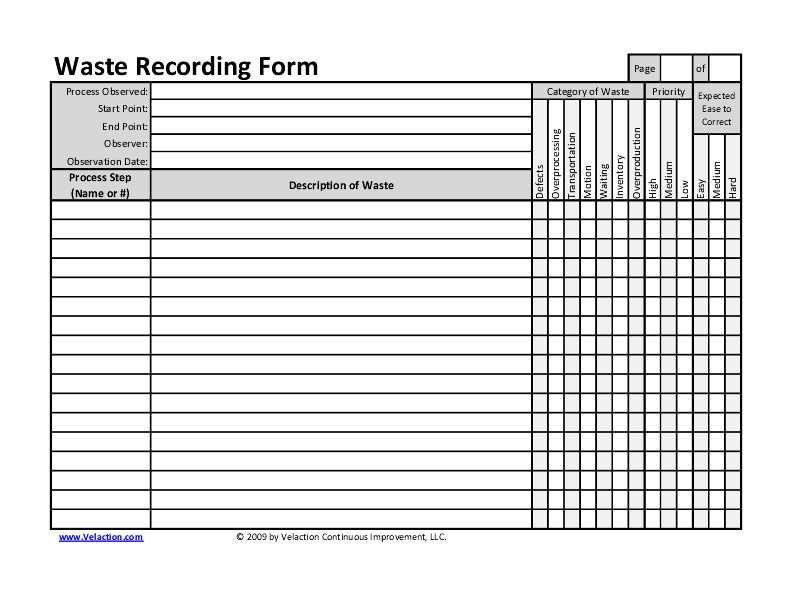CLOSED MITT
CLOSED MITT is an acronym used to categorize waste. It expands on the traditional 7 Wastes that are frequently used in Lean efforts. The origin of CLOSED MITT is unknown, but it has grown in use over the years. Since its early days, it has come into fairly common mention in a variety of publications and Lean websites.

Watch a closely related video on the 7 Wastes.

CLOSED MITT stands for the following types of wastes:
- C-Complexity. Make processes as simple as possible. This includes managerial processes.
- L-Labor. Don’t waste people’s time. This includes waiting, walking, and wasted steps.
- O-Overproduction. Don’t make more than customers need. This is widely considered to be the worst form of waste because it creates or hides all the other wastes.
- S-Space. Space costs money. Even if there is a lot of available space in a facility, use as little as possible. You never know what else you might need it for down the road.
- E-Energy. Running machines, heating facilities, and keeping the lights on costs money. Listen in your facility for hissing from air hoses, or look for computers on at night. All of this adds to your costs.
- D-Defects. Doing things twice costs twice as much, or more, than doing it right the first time. It gets even worse if the defects are not identified until many process steps later.
- M-Materials. Look in your dumpsters for scrap. Make sure you are using raw materials efficiently.
- I-Idle Inventory or Idle Materials. “Idle materials” is another name for inventory. Whether it is raw material, components, or finished goods, a great deal of money is tied up in purchasing and managing the inventory.
- T-Time. Time is a non-renewable resource. Don’t waste it. This can be in the form of waiting for a process to finish, shutting down key processes for breaks and lunch, or waiting for communication.
- T-Transportation. Moving stuff and people around takes time, space, etc. Anytime someone is walking somewhere, or a forklift is moving, your waste radar should start going off.
Honing your ability to spot waste significantly enhances your opportunities to make improvements. Often, as people become familiar with a process, they overlook the waste that they see every day. Having a mnemonic device like CLOSED MITT helps them go over waste in a systematic way. People seem to have an easier time finding waste when it is divided into categories.
In many kaizen events, part of the process includes a waste walk in which the team watches the process with an eye for waste. Teams will often use check sheets organized by either the 7 wastes, or CLOSED MITT to help uncover as many problems as possible.
As a leader, keep a critical eye open for waste. Ask questions about why things are done the way they are. Don’t let teams become complacent about waste in their areas.
![]()
Play a sample…

CLOSED MITT Warnings:
- Make sure everyone in the organization is using the same types of waste. It can lead to confusion if different terminology is used.
- Don’t spend too much effort trying to categorize the type of waste. The most important part is identifying it in the first place.
- Leaders must help eliminate the waste that teams identify, or team members will stop highlighting it.

While identifying and removing waste helps the bottom line of the company, it also plays a big role in reducing your own frustration. Much of the waste you face is linked to things that make your job harder than it needs to be.
Removing waste also helps your work flow more smoothly, which tends to improve your relationship with your boss. Fewer problems means fewer negative interactions with your manager.

Choose a version of waste categorization and stick with it. We generally recommend using the 7 Wastes because that version is more commonly used. It tends to create less confusion when interacting with new employees and outsiders such as customers and vendors.
You should also be coaching your team to talk in terms of waste. When they see a problem, address the…
Extended Content for this Section is available at academy.Velaction.com

Key Points about CLOSED MITT:
- Categorizing waste helps people identify and communicate problems better.
- Consistency in terminology is important. Try to get the whole organization using the same categories of waste.
![]()
What’s Next?
- Decide on whether your organization will be using CLOSED MITT or the traditional 7 Wastes.
- Train teams on Identifying Waste.
- Coach teams on recording waste in their own areas.
- Prioritize issues and eliminate the worst wastes.
![]()
Visit our waste recording form page to download that tool for free. It is a great tool that you can use to identify the seven forms of waste, and start thinking about which ones to work top eliminate first.



0 Comments